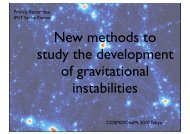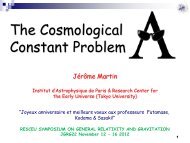Higher (second) order gauge invariant perturbation theory - RESCEU
Higher (second) order gauge invariant perturbation theory - RESCEU
Higher (second) order gauge invariant perturbation theory - RESCEU
Create successful ePaper yourself
Turn your PDF publications into a flip-book with our unique Google optimized e-Paper software.
Second-<strong>order</strong> <strong>gauge</strong>-<strong>invariant</strong><br />
cosmological <strong>perturbation</strong> <strong>theory</strong>:<br />
--- Recent development and problems ---<br />
Kouji Nakamura (NAOJ)<br />
with Masa-Katsu Fujimoto (NAOJ)<br />
References :<br />
K.N. Prog. Theor. Phys., 110 (2003), 723.<br />
K.N. Prog. Theor. Phys., 113 (2005), 413.<br />
K.N. Phys. Rev. D 74 (2006), 101301R.<br />
K.N. Prog. Theor. Phys., 117 (2007), 17.<br />
K.N. Proc. of LT7 (2008)<br />
K.N. Phys. Rev. D 80 (2009), 124021.<br />
K.N. Prog. Theor. Phys. 121 (2009), 1321.<br />
K.N. Adv. in Astron. 2010 (2010), 576273.<br />
K.N. in preparation.<br />
(arXiv:gr-qc/0303039).<br />
(arXiv:gr-qc/0410024).<br />
(arXiv:gr-qc/0605107).<br />
(arXiv:gr-qc/0605108).<br />
(arXiv:0711.0996[gr-qc]).<br />
(arXiv:0804.3840[gr-qc]).<br />
(arXiv:0812.4865[gr-qc]).<br />
(arXiv:1001.2621[gr-qc]).<br />
1
I. Introduction<br />
The <strong>second</strong> <strong>order</strong> <strong>perturbation</strong> <strong>theory</strong> in general relativity<br />
has very wide physical motivation.<br />
– Cosmological <strong>perturbation</strong> <strong>theory</strong><br />
• Expansion law of inhomogeneous universe<br />
(ΛCDM v.s. inhomogeneous cosmology)<br />
• Non-Gaussianity in CMB (beyond WMAP)<br />
– Black hole <strong>perturbation</strong>s<br />
• Radiation reaction effects due to the gravitational wave emission.<br />
• Close limit approximation of black hole - black hole collision<br />
(Gleiser, et.al (1996))<br />
– Perturbation of a star (Neutron star)<br />
• Rotation – pulsation coupling (Kojima 1997)<br />
There are many physical situations to which higher <strong>order</strong><br />
<strong>perturbation</strong> <strong>theory</strong> should be applied.<br />
2
The first <strong>order</strong> approximation of our universe<br />
from a homogeneous isotropic one is revealed by<br />
the recent observations of the CMB.<br />
• It is suggested that the fluctuations<br />
are adiabatic and Gaussian at least in<br />
the first <strong>order</strong> approximation.<br />
• One of the next research is to clarify<br />
the accuracy of this result.<br />
– Non-Gaussianity, non-adiabaticity<br />
…and so on.<br />
(Bennett et al., (2003).)<br />
• To carry out this, it is necessary to discuss <strong>perturbation</strong> theories<br />
beyond linear <strong>order</strong>.<br />
• The <strong>second</strong>-<strong>order</strong> <strong>perturbation</strong> <strong>theory</strong> is one of such <strong>perturbation</strong><br />
theories.<br />
c.f. Non-Gaussianity is a topical subject also in Observations.<br />
– E. Komatsu, et al., APJ Supp. 180 (2009), 330;<br />
arXiv:1001.4538[astro-ph.CO].<br />
– The first full-sky map of Planck was<br />
press-released on 5 July 2010!!! -----><br />
3<br />
3
However, general relativistic <strong>perturbation</strong> <strong>theory</strong><br />
requires very delicate treatments of “<strong>gauge</strong>s”.<br />
It is worthwhile to formulate the<br />
higher-<strong>order</strong> <strong>gauge</strong>-<strong>invariant</strong> <strong>perturbation</strong><br />
<strong>theory</strong> from general point of view.<br />
• According to this motivation, we have been formulating the<br />
general relativistic <strong>second</strong>-<strong>order</strong> <strong>perturbation</strong> <strong>theory</strong> in a<br />
<strong>gauge</strong>-<strong>invariant</strong> manner.<br />
– General framework:<br />
• K.N. PTP110 (2003), 723; ibid, 113 (2005), 413.<br />
– Application to cosmological <strong>perturbation</strong> <strong>theory</strong> :<br />
• Einstein equations (the first-<strong>order</strong> : scalar mode only):<br />
– K.N. PRD74 (2006), 101301R; PTP117 (2007), 17.<br />
• Equations of motion for matter fields:<br />
– K.N. PRD80 (2009), 124021.<br />
• Consistency of the 2 nd <strong>order</strong> Einstein equations including<br />
all modes (perfect fluid, scalar field):<br />
– K.N. PTP121 (2009), 1321.<br />
• Summary of current status of this formulation:<br />
– K.N. Adv. in Astron. 2010 (2010), 576273.<br />
4
In this poster, ...<br />
• I will give a brief explanation of our <strong>gauge</strong>-<strong>invariant</strong><br />
formulation of the <strong>second</strong>-<strong>order</strong> cosmological<br />
<strong>perturbation</strong>s through the single scalar field case<br />
(as a simple example of matter field).<br />
5
II. The <strong>second</strong> kind <strong>gauge</strong> in GR.<br />
(Stewart and Walker, PRSL A341 (1974), 49.)<br />
Physical spacetime (PS)<br />
“Gauge degree of freedom” in<br />
general relativistic <strong>perturbation</strong>s<br />
arises due to general covariance.<br />
In any <strong>perturbation</strong> theories, we<br />
always treat two spacetimes :<br />
– Physical Spacetime (PS);<br />
– Background Spacetime (BGS).<br />
Background spacetime (BGS)<br />
In <strong>perturbation</strong> theories, we always write equations like<br />
Through this equation, we always identify the points<br />
on these two spacetimes and this identification is called<br />
“<strong>gauge</strong> choice” in <strong>perturbation</strong> <strong>theory</strong>.<br />
6
Gauge transformation rules of each <strong>order</strong><br />
• Expansion of <strong>gauge</strong> choices :<br />
We assume that each <strong>gauge</strong> choice is an exponential map.<br />
(Sonego and Bruni, CMP, 193 (1998), 209.)<br />
-------><br />
• Expansion of the variable :<br />
• Order by <strong>order</strong> <strong>gauge</strong> transformation rules :<br />
Through these understanding of <strong>gauge</strong>s<br />
and the <strong>gauge</strong>-transformation rules,<br />
we develop <strong>second</strong>-<strong>order</strong> <strong>gauge</strong>-<strong>invariant</strong> <strong>perturbation</strong> <strong>theory</strong>. 7
III. Gauge <strong>invariant</strong> variables<br />
metric <strong>perturbation</strong> : metric on PS : , metric on BGS :<br />
metric expansion :<br />
Our general framework of the <strong>second</strong>-<strong>order</strong> <strong>gauge</strong> <strong>invariant</strong><br />
<strong>perturbation</strong> <strong>theory</strong> was based on a single assumption.<br />
linear <strong>order</strong> (assumption) :<br />
Suppose that the linear <strong>order</strong> <strong>perturbation</strong><br />
is decomposed as<br />
so that the variable and are the <strong>gauge</strong> <strong>invariant</strong> and the<br />
<strong>gauge</strong> variant parts of , respectively.<br />
These variables are transformed as<br />
under the <strong>gauge</strong> transformation .<br />
Recently, this assumption has been justified on generic BGS.<br />
In cosmological <strong>perturbation</strong>s, we may choose as<br />
(longitudinal <strong>gauge</strong>, J. Bardeen (1980))<br />
8
Second <strong>order</strong> :<br />
Since the above assumption for the linear-<strong>order</strong> metric<br />
<strong>perturbation</strong> has been justified, we can always decompose<br />
the <strong>second</strong> <strong>order</strong> metric <strong>perturbation</strong>s as follows :<br />
where is <strong>gauge</strong> <strong>invariant</strong> part and<br />
Under the <strong>gauge</strong> transformation<br />
is transformed as<br />
is <strong>gauge</strong> variant part.<br />
, the vector field<br />
In the case of cosmological <strong>perturbation</strong>s, we may choose the<br />
components of as (Poisson <strong>gauge</strong>)<br />
9
Perturbations of an arbitrary matter field Q :<br />
Using <strong>gauge</strong> variant part of the metric <strong>perturbation</strong> of each<br />
<strong>order</strong>, <strong>gauge</strong> <strong>invariant</strong> variables for an arbitrary fields Q other<br />
than metric are defined by<br />
First <strong>order</strong> <strong>perturbation</strong> of Q :<br />
Second <strong>order</strong> <strong>perturbation</strong> of Q :<br />
These implies that each <strong>order</strong> <strong>perturbation</strong> of an arbitrary<br />
field is always decomposed as<br />
: <strong>gauge</strong> <strong>invariant</strong> part : <strong>gauge</strong> variant part<br />
10
Perturbations of Einstein tensor and Energy momentum tensor<br />
• First <strong>order</strong> :<br />
,<br />
• Second <strong>order</strong> :<br />
,<br />
,<br />
: <strong>gauge</strong> <strong>invariant</strong> part : <strong>gauge</strong> variant part<br />
,<br />
11
Perturbations of the Klein-Gordon equation<br />
• Klein-Gordon equation ( )<br />
• Perturbative expansion of the Klein-Gordon equation :<br />
• We can show that each <strong>order</strong> <strong>perturbation</strong> of this<br />
Klein-Gordon equation is decomposed into the<br />
<strong>gauge</strong>-<strong>invariant</strong> and <strong>gauge</strong>-variant parts as<br />
: <strong>gauge</strong> <strong>invariant</strong> part : <strong>gauge</strong> variant part 12
IV. Einstein eqs. and Klein-Gordon eq.<br />
We impose the Einstein equation of each <strong>order</strong>,<br />
Then, the Einstein equation of each <strong>order</strong> is automatically given<br />
in terms of <strong>gauge</strong> <strong>invariant</strong> variables :<br />
linear <strong>order</strong> :<br />
<strong>second</strong> <strong>order</strong> :<br />
Further, each <strong>order</strong> <strong>perturbation</strong> of the Klein-Gordon equation is<br />
also automatically given in the <strong>gauge</strong> <strong>invariant</strong> form :<br />
• Background : • Linear <strong>order</strong> :<br />
• Second <strong>order</strong> :<br />
We do not have to care about <strong>gauge</strong> degree of freedom at least<br />
in the level where we concentrate only on the equations. 13<br />
.
Second <strong>order</strong> Einstein equations (scalar)<br />
• Master equation of the <strong>second</strong>-<strong>order</strong> Einstein equations :<br />
• Momentum constraint (scalar mode) :<br />
• potential <strong>perturbation</strong> :<br />
• traceless part of the spatial component of Einstein equation :<br />
Here, Γ 0 , Γ i , and Γ ij are the collections of the<br />
quadratic terms of linear <strong>order</strong> <strong>perturbation</strong>s. 14<br />
.
Second <strong>order</strong> Klein-Gordon equation<br />
• The <strong>second</strong>-<strong>order</strong> <strong>perturbation</strong> of the Klein-Gordon equation<br />
in the cosmological situation is given by<br />
where<br />
This <strong>second</strong>-<strong>order</strong> Klein-Gordon equation is not independent<br />
of the <strong>second</strong>-<strong>order</strong> Einstein equations.<br />
We use this fact to check the consistency of all equations.<br />
15
V. Consistency of 2 nd -<strong>order</strong> equations<br />
• Since momentum constraint for the vector mode is an initial value<br />
constraint, it should be consistent with the evolution equation of<br />
the vector mode. This consistency of equations leads an identity :<br />
Further, through this identity, we can confirm that the all Einstein<br />
equations for the <strong>second</strong>-<strong>order</strong> scalar mode are consistent with each other.<br />
• The consistency between the Klein-Gordon equation and the<br />
Einstein equation of the <strong>second</strong> <strong>order</strong> leads an identity :<br />
• Actually, we have confirmed that these identities are guaranteed<br />
by the background Einstein equations and the first-<strong>order</strong><br />
<strong>perturbation</strong>s of the Einstein equation.<br />
Our derived set of equations for the <strong>second</strong>-<strong>order</strong><br />
<strong>perturbation</strong>s are self-consistent.<br />
16
VI. Summary<br />
Based on the general framework of the general relativistic 2 nd -<strong>order</strong><br />
<strong>perturbation</strong>s in [K.N., PTP 110 (2003), 723; ibid, 113 (2005), 413.],<br />
we have derived the all components of the 2 nd -<strong>order</strong> Einstein<br />
equations and equations of motion for matter fields in<br />
<strong>gauge</strong>-<strong>invariant</strong>, and self-consistent manner.<br />
[ K.N., arXiv:0804.3840[gr-qc]; PTP 121 (2009), 1321. ]<br />
17
Current Status of our formulation (Problems)<br />
• Second-<strong>order</strong> cosmological <strong>perturbation</strong>s (in progress)<br />
Second-<strong>order</strong> <strong>perturbation</strong> of the Einstein equation :<br />
In the case of the cosmological <strong>perturbation</strong>s,<br />
these terms are almost completely derived.<br />
The next task is to clarify the<br />
nature of the <strong>second</strong>-<strong>order</strong><br />
<strong>perturbation</strong>s of this energy<br />
momentum tensor.<br />
• Incomplete parts are in the treatment of zero-mode!!!<br />
– At this moment, zero-modes are not included in our<br />
formulation, which should be included for completion.<br />
(Now I am trying!!!!!)<br />
• Classical behaviors of the <strong>second</strong>-<strong>order</strong> <strong>perturbation</strong>s.<br />
– This is a preliminary step to clarify the quantum behaviors<br />
of <strong>perturbation</strong>s in inflationary universes.<br />
• Comparison with the long-wavelength approximations.<br />
• Multi-fluid or multi-field system<br />
• Einstein Boltzmann system (treatments of photon and<br />
neutrino) [cf. N. Bartolo, et. al., (2006-); C. Pitrou, et.<br />
al., (2008-); L. Senatore, et. al. (2008-).]<br />
---> Non-linear effects in CMB physics.<br />
18<br />
18




![2011年度 [PDF: 12.1 MB] - RESCEU - æ±äº¬å¤§å¦](https://img.yumpu.com/25708645/1/184x260/2011aa-pdf-121-mb-resceu-aeaaa.jpg?quality=85)





